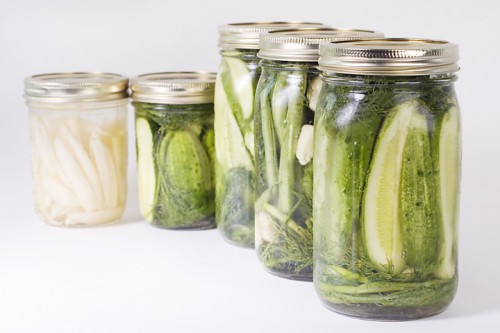By JJ Gonson
Ahhhh, pickles! Them briny harbingers of summer time. Diced into potato salad, stacked on plates by hamburger-laden grills, and dawdling deep in the depths of spiced tomato-based adult beverages. Pickles are everywhere, well loved, and, happily, very easy to produce for your own delectation.
Before you get down to the process of pickling, it is key to understand that there are many, many different items that fall under the pickle category. To make pickles, some cultures use age, some use antimicrobial spices, some use pressure. You could spend a lifetime exploring the possibilities of corning for preservation.
The word ‘pickle’ describes a sour bath in which one soaks vegetables to preserve them for eating later. This bath includes a high percentage of acid, (equal to a PH below 4.6) usually in the form of vinegar, and leans towards tartness in flavour, although in some cases a lot of sugar can be added to make a sweet pickle, like those used for pickle relishes and bread and butter chips. Vinegar pickles, whether cucumber, pepper, carrot or any other vegetable, can be put into sterile jars and sealed by boiling in water, to be kept on the shelf before eating, as they have a PH level high enough to keep dangerous bugs at bay. This form of canning is convenient, but the result is not going to be fresh and crunchy, and therefore, vinegar pickles are soft. We throw the word about wantonly, but the truth is: if there is no vinegar, technically speaking, what you are eating is not a pickle.
A very crunchy and saltier ‘pickle’ is actually more likely to have been brined, or made in a salt water bath, rather than vinegar. This bath will slow down decay, but these veggies have to stay refrigerated or they will rot. Since they don’t keep forever these are often referred to as “quick pickles”, and will produce something flavored more like a traditional Kosher Dill, rather than the sour classic spear style of pickle.
For centuries, many cultures have harnessed anaerobic fermentation processes to create a combination of the salty and sour. Fermentation usually starts with just salt, and the water from the vegetables themselves create the brine. As the vegetables break down, they sour, and the result is wildly varied, depending on many factors: the food you are fermenting, the air temperature and humidity, the amount of salt, etc. Fermentation occurs in a controlled environment, and the resulting pickles are removed to cold storage when they are ready, where they will last for a long time. Fermenting cucumbers is a little tricky as they mold easily, but sauerkraut and kimchi are less challenging with very satisfying results, and are a good place for the amateur fermenter to start.
I can only caution, once you jump into the world of pickling, it can become an obsession. You may end up losing counterspace to lines of sterilized glass jars and your kitchen may take on a lingering scent of vinegar. I would like to comfort you with the reassurance that you will make many friends. Everyone loves a pickle!
Here are a couple of basic recipes to start playing with:
Classic Kosher Dills
The easiest snack in the world to make!
- Add 1/3 cup of Kosher salt to 1 cup boiling water.
- Stir to dissolve the salt in the water and add ice, stirring until it stops melting, and the brine is cooled.
- Pour over whatever veggies you want to brine - cukes, green beans, fennel…. with a handful of dill or fennel greens and a couple of cloves of garlic, broken but not mashed.
- Weight the brining veggies so that they are completely submerged in liquid and let it sit at room temp for 24 hours, then refrigerate.
If the “pickles” get too salty after a few days, pour off the brine and replace it with clear water
Sauerkraut
From Alex Lewin/How 2 Heroes
Ingredients
- ¼ of a cabbage (400 gm) or more of cabbage (green, red, or a mixture)
- 8 gm (1½ tsp) sea salt
Special Equipment
- 1-pint mason jars
- digital kitchen scale
- large mixing bowls
How-to
- Quarter the cabbages. Discard the cores or keep them and use them, as you like
- Weigh the cabbage
- Measure salt equal to roughly 2% of the weight of the cabbage. (Metric measures make this easier.) Alternatively, as in this video, measure 1½ tsp of salt per 400 gm (¼ cabbage). Too much salt will slow down the fermentation, and result in an overly-salty product; too little salt will increase the likelihood of mushiness or even putrefaction
- Slice or shred the cabbage using a large chef ’s knife, a shredding attachment on a food processor, or whatever tool you like
- Place the cut cabbage in a large mixing bowl, adding salt as you go. When everything is in the bowl, mix and squeeze the mixture with (clean!) hands for a minute or two, until the cabbage has started to release liquid
- Pack the mixture as tightly as you can into 1-pint mason jars, leaving at least an inch of space at the top of each jar. Close the jars, and store them at room temperature, away from sunlight
- Once a day, open the jars and pack down their contents so that the liquid rises. If the liquid does not cover the cabbage completely after two days, add brine to cover. (The brine should be 2% salt by weight. Use filtered water; the chlorine in municipal tap water kills bacteria—that’s why it’s there!)
- Make sure to keep the cabbage covered with liquid thenceforth, otherwise your sauerkraut may discolor, dry out, or even become moldy. If you don’t leave enough space at the top of the jars, some of the liquid may leak out as the fermentation progresses. This is an inconvenience, but not a cause for alarm
- Taste the sauerkraut after a few days four days, and periodically thereafter. Depending upon ambient temperature, your taste, and other factors, the sauerkraut may be “ready” after 4 days, or after 4 months, or some time in between. When you decide it is “ready”, or slightly before, put it in a refrigerator or a cool cellar, or bury it in the ground. The cooler the environment, the slower the subsequent fermentation
Variations
- Sea salt contains healthy trace minerals. Prefer sea salt over kosher salt. In any case, do not use iodized table salt, and do not use salt containing “anti-caking agents.” (Check the list of ingredients.)
- Use a mixture of green cabbage and red cabbage to make pink sauerkraut.
- Herbs and spices may be added when making the sauerkraut. For instance, you can add a teaspoon or more of caraway seeds per pound of cabbage. (Or fennel seeds, or anise seeds. Toast them first if you like.) On the other hand, making unseasoned sauerkraut gives you added flexibility; you can always season your sauerkraut a la minute.
- Precise kitchen scales can be bought inexpensively over the Internet. A digital scale with 1-gram resolution is very useful for cooking and baking. 0.1-gram resolution can be useful, too, when working with spices, for instance.
- On sandwiches, food-processor-shredded sauerkraut works well. On its own, hand-cut sauerkraut is crunchier and perhaps more interesting.


